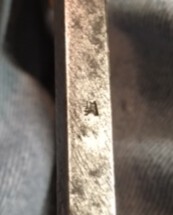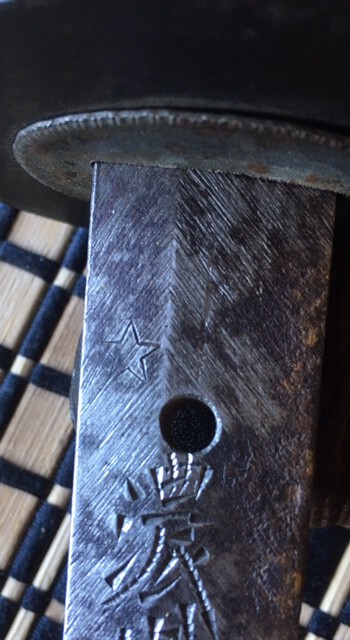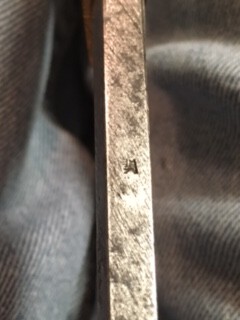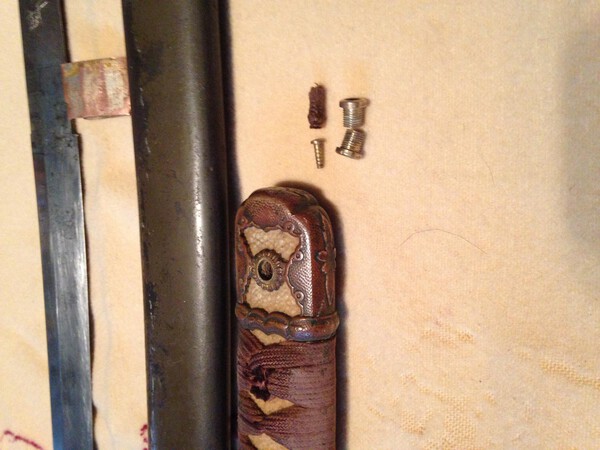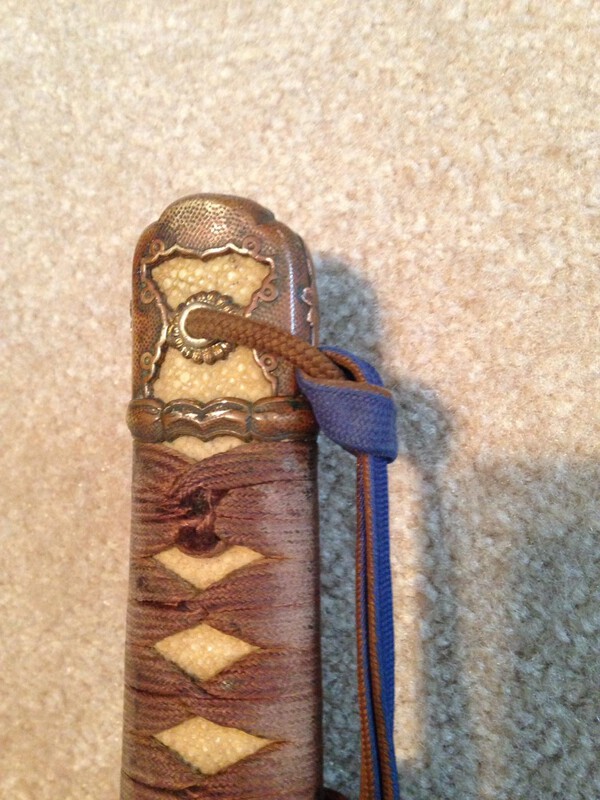-
Posts
12,932 -
Joined
-
Last visited
-
Days Won
154
Everything posted by Bruce Pennington
-
Shamsy or Stegel are the go-to guys on Type 95s, and they may correct me on this - but there were NO Seki stamped 95s. The tsuka has that course "sand-blased" look, polished to hide it. Numbers are typed with cutting edge up, like a Nagoya Arsenal blade, but no arsenal stamp on the blade or fuchi. Lousy seppa work. What is that inside the holes of the tsuba? It looks like wood! Dot pattern on the face of the tsuba is wrong. It would be good to see the blade tip, but I've seen enough. A weak attempt at reproducion/fakery.
-
Good luck! Let me know if you find anything on it!
-
Brad, hopefully a real translator will chime in (otherwise I'd take it to the Translation help forum on this site), but I agree. It looks more like "Bushu" to me.
-
Ok, I see that, but have no idea what caused it. Don't think that is common, as you asked, but I don't see it as a problem either.
-
I'm not sure what you mean by wear/ware under the habaki. Do you mean those horizontal lines?
-
That's gorgeous Brad! Your collection is growing! Saw your post on the stamp. All I can say is the list of "unknowns" is growing. Thanks for adding it to the Stamps thread.
-

Mantetsu Suriage Or Wak?
Bruce Pennington replied to obiwanknabbe's topic in Military Swords of Japan
Kurt, do you own this? Pretty cool, with the "Namizuzu street emblem" stamp! -
If you buy the Type 3, Rinji, you get an NCO tassel with it!!!
-
Thanks Dave! Ant there lies my problem- I no longer use any Windows based devices! Harumph. Steve, I’ve enlarged it at home and it’s definitely a Seki.
-
Stephen, Sorry my friend. I’m the “pot calling the kettle black” because I have no idea about how to make my picture bigger. I’m just not tech savvy in that regard. DaveR gave me a tip once that worked, but I don’t remember what it was.
-
Stephen, I love ya man, but you GOTTA learn to use the Zoom function, dude! Here, I tried enlarging:
-
Daniel, I found it here: http://www.nihontocraft.com/Kanehide.html. They are speculating that the mune stamp may be from the Seki Token contractor. I was wondering about the old story about the Seki stamp, how it was originally a craftsman guild stamp that was later absconded and taken over by the arsenals. This would have happened long before my 1945, or the nihontocraft's 1944 blades were made though. But I still wonder if it's not some sort of contractor's approval/inspection mark on these star-stamped blades. Arsenals tended to put their marks on the nakago itself for a non--traditional blade.
-
Here they are Stephen. Daniel, that is interesting, I'll have to try to find it, because I'm seeing other mini arsenal stamps on nakago mune as well.
-

Newly Acquired Type 95 And Type 98(?)
Bruce Pennington replied to DavidCarroll's topic in Military Swords of Japan
Ed, It's a very weak acid and takes a lot of elbow-grease to work the rust off. I've mostly used it on seppa that had a lot of grime on them. It won't take that annoying black stain out of blades, but it will help remove active built up rust. Afterwards, I use the alcohol to clean and then apply oil. -
Stephen, Talking of needing coffee - Woh, I just re-read the post and can see I totally took Rich's comment 180 out. I thought he was saying his blade WAS gendaito with Showa stamp, but he was saying that it wasn't. Sorry guys! On the issue of exceptions to the rule, I can only think of one off the top of my head, for now. I have a Star-stamped Rinji (type 3) that also has a Seki stamp on the nakago mune. It's a Kunitoshi, dated 1945.
-
Rich, just another example of "there are exceptions to everything!". The Showa stamp is "supposed" to mean non-traditionally made. The more I study this stuff the more exceptions to the rule I see.
-

Newly Acquired Type 95 And Type 98(?)
Bruce Pennington replied to DavidCarroll's topic in Military Swords of Japan
David, nice collection with signifcant family history! I have "cleaned up" several of my swords over time and agree wtih both the guys above - do less rather than more. On my first attempt to buff up some fittings on my dad's sword, I realized in removing rust/oxidation, I was also removing some of the original coloration of the fitting! Ouch! A lot of guys have been recommneding pure alcohol (found at hardware stores) for the blade. I tried that recently and it does put a shine to the bare blade, however it doesn't seem to remove any rust. The method I like is to take a rag and sprinkle a small pile of baking soda on it. Drop some lemon juice into the soda, and while it fizzes, rub the rust with the mixture. I would only do this on the Type 95 blade and metal parts. Like John said, your Type 98 might be a low end blade, HOWEVER, the handguard looks civilian and I've seen several family heirloom blades fitted with the leather combat cover like this. So, it's "possible" that the blade might be an older blade worth exploring. It'd remove the handle and bring us some pics of the tang. -
Dang Ian, you’re right! I had the same’ in mind when I wrote that.
-
That's the second one I've seen in the past year. Does anyone know what the certificate says? Owner? Reasons?
-
To expand on John's post, Army ito was "almost" always brown, but there are some examples of blue and even green ito. Navy is almost always black, but Ohmura's site shows one with purple ito. And like John said, this had nothing to do with rank, it was simply a personalized customization for the officer making the purchase. There is an unusual combo, where a naval officer is working jointly on land with army, and you will see the army brown ito on a navy gunto (there are actual period pictures of this).
-
Very interesting indeed! The backside of the ana and frontside don't even look like they come from the same gunto! At first, I thought the blade may have been made with another tsuka, and then refitted for the kaigunto, and the ana was just a tad bit off, so the backside was angled and filled. But the front side of the hole is perfect. Hmmm. And WHAT a kamon!!! Or is it an Imperial Household emblem?
-
I also have a gendaito, star-stamped blade with a Seki stamp on the nakago mune. I'm thinking this is getting to be a trend, that inspector stamps on the mune are not connected with the order to stamp non-traditional blades.
-
Frederik, It is one of the many Arsenal Inspector stamps that were used on blades that were not made in the traditional way. The ordanance was passed in 1933 because non-traditionally made blades were getting into the collecting world that could not be distinguished from traditionally made blades. The "Showa" stamp was the primary stamp, but all arsenal stamps were used this way as well. The practice didn't make it into regular use until 1940, so there are many non-traditional blades made before that date that may not have any stamps. The "na" was used by inspectors at the Nagoya Army Arsenal. Each of the arsenals had their own stamp.
-
Chris, I'm not familiar with "Saka". Can you give an example of it, and what does it represent?
-
My dad's Mantetsu came with a cord sarute. It was broken/torn off with only the nub still inside the barrel screw. I've since found a replacement.




